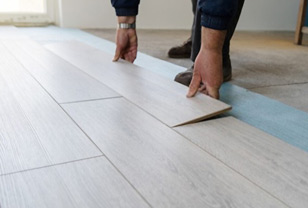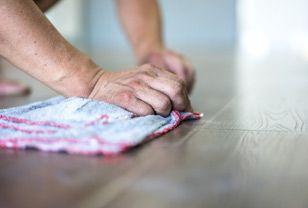How Much to Install Laminate Flooring? The Truth Contractors Won’t Say
In most scenarios, the cost of installation is not made clear, and it exacerbates the issue. The flooring could wear down quickly due to provider shortcuts. You could also find yourself shelling out more than anticipated to your service provider.
TheKingLive guide uses real-world price ranges and commonly accepted installation practices to explain how prices are formed in the real world, who keeps the money, and, most importantly, the question of whether you should really install the laminate flooring yourself or outsource the service to a professional.
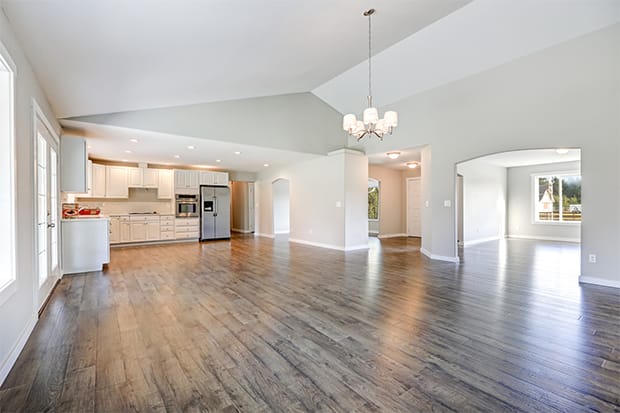
Laminate flooring is the popular choice of many people nowadays
Fast Answer: Cost of Laminate Flooring Installation
In a nutshell:
-
When installed professionally, the cost of materials and labor is approximately $5 to $12 per square foot.
-
DIY: for materials alone, entry-level products cost around $1 to $4 per square foot.
Example: a 200 square foot room
-
Professional installation usually costs $1,000 to $2,400.
What Does It Cost to Do Your Own DIY Projects?
-
Materials for DIY are between $200 and $800.
-
Homeowners can save as much as 70% of the total by properly installing laminate flooring themselves.
Prices of home renovation projects vary based on the area of the home and the particular flooring materials and laminate design choices, as well as the complexity and prep work required for the room.
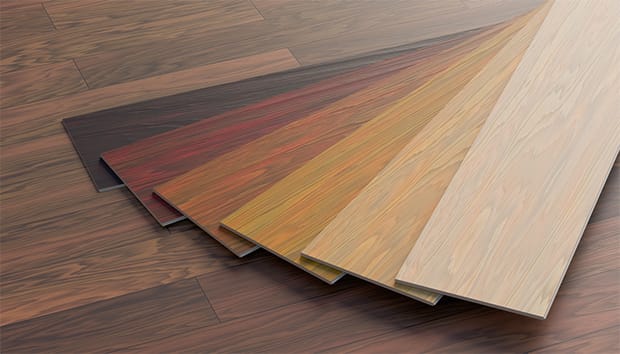
The cost of installation may vary based on the style, thickness, and quality of the materials
Real Examples of Laminate Flooring Prices
Laminate flooring costs are made up of four basic components:
-
Materials
-
Labor
-
Prep work
-
Room specifications
Once you get acquainted with the four basic components of laminate flooring costs, quotes for laminate flooring will be less challenging.
Figuring out laminate installation costs, how long it takes, and how much to charge to install laminate flooring? You will often see these price ranges when people look up how much it costs to get laminate flooring installed. These are what you'll typically find in trusted homeowner guides.
-
Getting laminate flooring professionally installed (including materials and labor) typically costs $5–$12 per square foot.
-
The materials typically included in this price are the required standard installation labor and underlayment, as well as the planks themselves.
-
If you're paying for materials only, you're likely looking at $1–$4 per square foot. That cost may vary somewhat because of the brand, texture, and finish you choose.
-
For this reason, DIY materials for a 200 square foot room are likely to cost between $200 and $800.
-
Floors using herringbone or chevron styles add complexity and cost to your design, around $8–$13 per sq. ft.
-
For laminate materials only, the more basic choices cost around $1.00–$3.75 per sq. ft.
-
In select areas, basic underlayment and small rooms completing projects under $300 can be achieved, assuming you're doing the labor.
What Factors Will Increase or Reduce Your Laminate Flooring Installation Cost?
Alongside the brand and overall quality, how much to install laminate flooring also depends heavily on the design and look of the laminate flooring. Wood species like hickory, oak, and maple are commonly used for laminate flooring, as are more intricate finishes like stone-look, tile-look, broad plank, and hand-scraped designs.
For laminate flooring, the thickness is usually anywhere between 6mm to 12mm.
-
The thicker the laminate flooring planks are, the more durable they will be.
-
Thicker laminate flooring also makes for a more sound-proofed floor.
Which brings to the next point:
-
If you want to check a product for its durability, look at the durability ratings (AC3–AC5) and warranty length.
When you use watertight inner cores, built-in acoustic underlayment, and other seamless installation features, more laminate flooring installations can be finished more quickly.
Things like realistic surfaces and ultra-wide planks add cost to the laminate flooring installation.
Levels of Laminate Flooring Materials
-
A budget-grade laminate flooring option (ranging from $1 per sq. ft. to $2 per sq. ft.) is the most budget-friendly option, and is best for very low-traffic areas or guest rooms.
-
Mid-range laminate flooring, ranging from $2–$4 per sq. ft., has better cores, more natural designs, and stronger warranties, and is common in living rooms and hallways.
-
High-end laminate flooring (over $4 per sq. ft.) often includes better visuals, more sophisticated textures, quieter performance, and more advanced locking systems.
Other Non-Obvious Costs That Homeowners Should Not Ignore
The price per box typically includes planks only. You still need to factor in these items when determining total costs for installing a laminate floor.
Removing Old Flooring
-
The cost to remove old flooring can be approximately $0.70–$4.00 per sq. ft., or up to $70.00 an hour.
-
DIY methods can save $100–$300 per room.
Underlayment and Vapor Barriers
Underlayments and vapor barriers help prevent moisture, smooth out small defects, and reduce noise.
-
It costs anywhere from $0.30 to $1.00 per sq. ft.
-
Some products may have an attached underlayment, which can be convenient and eliminate additional costs for materials.
Preparing the Subfloor
A stable base will be needed for a laminate floor.
-
Light leveling will usually cost about $1.50 to $3.00 per square foot.
-
Major repair or replacement can cost approximately $5.00–$7.00 per sq. ft.
Room Complexity and Labor
Angled rooms, stairs, herringbone pattern designs, and serious problems with subfloors will drive labor costs higher.
Moving furniture, trimming doors, and new trim work may or may not be included in price quotes.
Extra Materials and Overage
-
Add an additional 10–15% more planks for cuts and repair.
-
It will cost less in the long run if there is a possibility that a board will be damaged or a particular pattern will no longer be available. It will also save time.
Installation expertise often matters more than product brand labeling.
Laminate vs Other Flooring: Price and Lifetime
Compared with other common options:
-
Installed laminate flooring costs $4 to $12 per square foot.
It’s easy to maintain and fairly scratch-resistant. -
Luxury vinyl plank (LVP), depending on quality: $4+ per square foot.
It works for kitchens, baths, or basements since it is completely waterproof. -
Hardwood (engineered or solid), installed: usually between $8 and $25 or more per square foot.
Though the initial cost is higher, it may be refinished and often has strong traditional resale value. -
Carpet: usually $3 or more per sq. ft.
Though originally more affordable and comfy, in busy homes it tends to wear out faster.
Laminate sits in the middle in most homes: more durable and more “wood-like” than carpet, but less expensive and easier to maintain than hardwood. In very humid environments, the safer choice is usually waterproof laminate or LVP.
Do-It-Yourself Laminate Flooring: When Should It Pay?
If you don’t need specialized equipment and can measure and cut accurately, a DIY approach can be a real money-saver because labor can make up a big part of the total price.
Most laminate today uses a click-lock floating-floor system. Without nails or adhesive, the boards click together over the underlayment. DIYers have embraced laminate for its simplicity, and the TheKingLive team often hears the same thing from readers in real-world projects—especially when they’re trying to figure out how much to install laminate flooring and whether doing it themselves is worth the savings.
A DIY Real-World Laminate Story
Mark’s first estimate for new flooring came back at nearly $3,500 after he finally got tired of the stained carpet in his tiny living area. He spent a weekend watching installation videos, reviewing guides, and pricing laminate at a local store because the number felt impossible. Choosing a mid-range laminate, doing the demolition himself, and bringing in a helpful buddy for the cuts brought the total down to just above $1,400. It took three long nights, but he now jokes that every board he steps on feels like saved money.
Are You a Good DIY Candidate?
If laminate flooring is your choice, it may make sense to consider going the DIY route (especially when you consider how much labor cost to install laminate flooring can add to the total) because of factors like these:
-
You’re comfortable with carpentry and have used a miter saw or circular saw on past projects.
-
The floor plan in your house is simple and you can easily reach every part of it.
-
You’ll be careful, really study the instructions, and take more time than usual.
-
You’d rather spend your time than pay for a professional’s labor.
On the other hand, it’s better to hire a professional installer (especially when you’re weighing how much it cost to install laminate flooring overall) if you have back, knee, or mobility issues; you want future problems covered with one clear point of responsibility; or you’re dealing with stairs, a split-level design, or a series of interconnected rooms and hallways.
In many homes, it comes down to this:
-
The first priority is the prep work.
-
Let the pro handle the difficult parts.

If you prefer to install the laminate flooring yourself, you will need to prepare some tools
Essential Operations, Materials, and Equipment
Here’s what you’ll likely need to install laminate flooring:
Measurement Tools
-
Tape measure
-
Circular saw or miter saw
-
Jigsaw
-
Utility knife
-
Carpenter’s square
Installation Accessories
-
Hitting block
-
Pull bar
-
Spacers
-
Rubber mallet
Personal Protection Equipment
-
Safety glasses
-
A dust mask
-
Hearing protection
-
Knee pads
Materials
-
Transition strips
-
Laminate planks (10–15% overage)
-
Glue (if needed)
-
A moisture barrier (especially over concrete)
Also, transition strips are one of the factors that influence the price of laminate flooring installation.
Routine Steps
-
First, acclimatize the boards for 48–72 hours.
-
Arrange the boxes in the room so the planks fit the space.
-
Prepare the subfloor.
If necessary, clean it, remove squeaks and rough spots, fill cracks, and put a vapor barrier over concrete. -
Put underlayment down.
Lay it flat at an even thickness, keeping seams tight without wrinkles or gaps. -
Plan your layout.
Start with the first row along the longest wall, using spacers to allow for an expansion gap of around 3/8 to 1/2 inch. -
Install remaining rows.
Use staggered joints, offset end joints 8–12 inches, click planks together, and close small gaps with a tapping block or pull bar. -
Finish the room.
Cut around obstructions, install the final row, remove spacers, and add baseboards or quarter rounds.
Combining plank lengths from more than one box helps achieve a more natural appearance by ensuring the subtle color variations mix seamlessly.
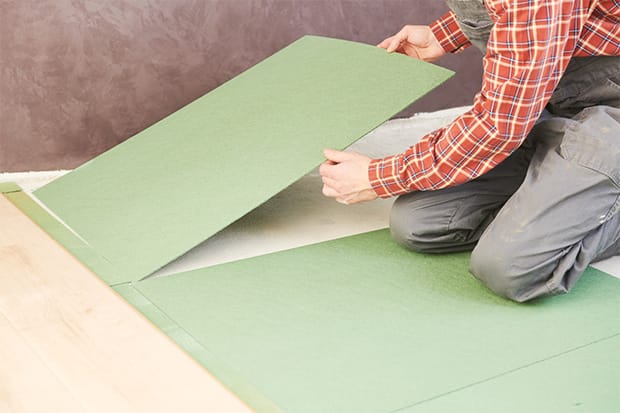
It is necessary to lay the underlayment for the laminate
Major Errors That Destroy Laminate Floors
Most failures in laminate flooring come from mistakes that should have been avoided in the first place. The flooring will be replaced due to laminate flooring failures before it should have been replaced for the first time.
-
Not letting the flooring acclimatize.
Floors that have not been acclimatized will either shrink or expand. Some planks will pop up while others will separate when they're under pressure. -
Ignoring the condition of the subfloor before installing.
Uneven or rough subfloors can create stress points that lead to noisy spots or hollow areas. -
Not allowing for expansion gaps.
Without enough space, the floor will push against the wall, which may lead to buckling of the floor. -
Installing cheap laminate in a high-traffic area to save costs.
Old, cheap, and thin laminates will be worn out and chipped in no time. You should aim for a good brand that is at least 8mm thick and is rated AC3 or better. -
Running out of flooring material.
You may find that matching a plank is a headache. Store it at a regulated temperature, and add 10–15% more than what you think you will need, along with any remaining planks.
Will You Hire a Professional or Will You Be Doing It Yourself?
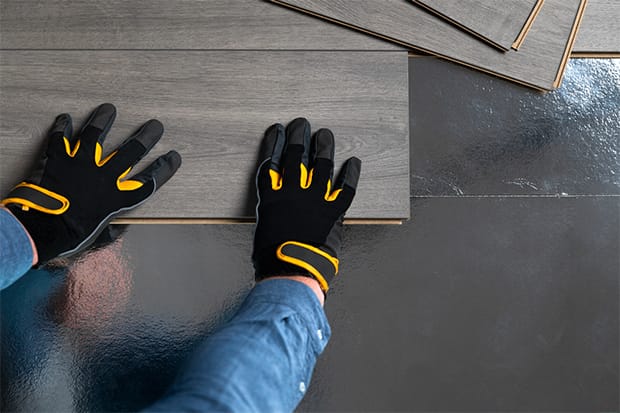
Installation of laminate flooring is not particularly difficult, and you may do it yourself to save money
There is not one best answer for this.
If you have a controllable environment, all necessary equipment, some level of professionalism, and an eagerness to cut labor costs, then DIY could be a good option.
On the other hand, if you have stairs to deal with, want to use some unique designs, have a lot of floor prep to do, or want a good reliable professional with a warranty, then you should usually just hire an installer.
For these complicated cases, a mixed method is what a lot of homeowners prefer for how much to install laminate flooring and laminate floor installation.
-
The pros handle the complicated and time-consuming parts.
-
You do the easier and faster parts to lower costs.
FREQUENTLY ASKED QUESTIONS
- 01. Is It Allowed to Put Laminate Flooring on Top of the Old Floor?
-
Yes, in most cases it is. Laminate flooring can be put on a leveled, strong, and smooth surface like vinyl, linoleum, or hardwood floors. Carpet, though, has to be taken out. Every layer causes the height of the floor to rise and can cause issues like too little door clearance and difficult transitions.
- 02. Which is Better, Laminate Flooring or Vinyl Plank Flooring?
-
The decision between the two will usually be dictated by location and the values of the home from the owner's perspective.
Since laminate flooring mimics the visual aspects of wood, it's as scratch-resistant as wood flooring. This means laminate flooring can be installed in living rooms and hallways that receive heavy amounts of foot traffic.
Vinyl plank flooring is completely waterproof and perfectly fitted for wet or humid areas, such as kitchens and bathrooms.
It's typical to see laminate flooring in dry, humid, and non-humid areas, and vinyl plank flooring in wet or humid areas.
- 03. How Do You Estimate the Total Cost of Laminate Flooring?
-
Let’s narrow down how much laminate flooring would approximately cost. To do that, you would need to do the following:
- To begin, measure the square footage for the floors you would like to install.
- Next, take that square footage and multiply it by the price per square foot for laminate and underlayment.
- If you were to hire someone, make sure to include their cost of installation as well (usually that is charged per square foot too).
- Then, make sure to add the following:
- Removal of old flooring
- Repair of subfloor
- New trimming or transitions
Lastly, add 10–15% for extra cuts and repairs.





